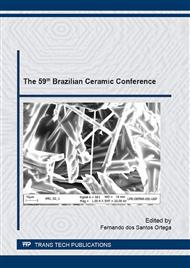[1]
B.A. Moreira, F.O. Arouca, J.J.R. Damasceno: Exacta Vol. 10 (3) (2012), p.341.
Google Scholar
[2]
R. Caenn, H.C.H. Darley, G.R. Gray: Composition and properties of drilling and completion fluids. (Gulf Publishing Company, sixth ed. Houston, 2011).
DOI: 10.1016/b978-0-12-383858-2.00009-3
Google Scholar
[3]
J.M. González, F. Quintero, J.E. Arellano, R.L. Márquez, C. Sánchez, D. Pernía: Colloids and Surfaces A: Physicochemical and Engineering Aspects Vol. 391 (2011), p.216.
DOI: 10.1016/j.colsurfa.2011.04.034
Google Scholar
[4]
E.V.N. Noronha, S.C. Magalhães, L.A. Calçada, C.M. Scheid, In: X Brazilian Congress of Cientific Initiation of Chemical Engineering, 2013, Rio de Janeiro.
Google Scholar
[5]
D.B.R. Silva, A.Q. Magioni, H. Oliveira Junior, F.O. Arouca, J.J.R. Damasceno, In: XIX Chemical Engineering Journey, 2014, Minas Gerais.
Google Scholar
[6]
R.D. Carico, F.R. Bagshaw, Description and use of polymers used in drilling, workovers, and completions, SPE Production Technology Symposium. (1978).
DOI: 10.2118/7747-ms
Google Scholar
[7]
R. Khan, E. Kuru, B. Tremblay, A. Saasen, An investigation of the extensional viscosity of polymer based fluids as a possible mechanism of internal cake formation, SPE International Symposium and Exhibition on Formation Damage Control. (2004).
DOI: 10.2118/86499-ms
Google Scholar
[8]
K.R.S. Fagundes, F.P. Fagundes, R.C.S. Luz, R.C. Balaban, In: 13º Brazilian Congress of Polymers, 2015, Rio Grande do Norte.
Google Scholar
[9]
Y. Chen, X. Ji, G. Zhao, X. Wang: Powder Technology Vol. 200 (2010), p.144.
Google Scholar
[10]
K.V. Farias, Influence of anionic humectant in the rheology and mudcake thickness of waterbased muds 2005. Dissertation.
Google Scholar
[11]
ANSI/API, Recommended Practice for Laboratory Testing of Drilling Fluids 13I, Eighth Edition, (2009).
Google Scholar
[12]
P. Souza Santos: Clay Science and Tecnology. (Edgard Blücher Publisher Ltda vol. 1 São Paulo, 1989).
Google Scholar
[13]
F. Jarek, D.M. Reis, R.S. Mauler, R.V. Barbosa, J.R. Kloss, In: 10º Brazilian Congress of Polimers, 2009, Foz do Iguaçu.
Google Scholar
[14]
R.R. Menezes, P.M. Souto, L.N.L. Santana, G.A. Neves, R.H.G.A. Kiminami, H.C. Ferreira: Ceramica Vol. 55 (2009), p.163.
Google Scholar
[15]
F. Boylu, K. Çinku, F. Esenli, M.S. Çelik: International Journal of Mineral Processing Vol. 94 (2010), p.196.
DOI: 10.1016/j.minpro.2009.12.004
Google Scholar
[16]
L.V. Amorim. Improvement, protection and recovery of waterbased fluids rheology for the use in the drillings of oil wells. 2003. Thesis.
Google Scholar
[17]
A. Besq, C. Malfoy, A. Pantet, P. Monnet, D. Righ: Applied Clay Science Vol. 23 (2003), p.275.
DOI: 10.1016/s0169-1317(03)00127-3
Google Scholar
[18]
F.Q. Mariani, J.C. Villalba, F.J. Anaissi: Orbital: The Electronic Journal of Chemistry Vol. 5 (4) (2013), p.1.
Google Scholar


